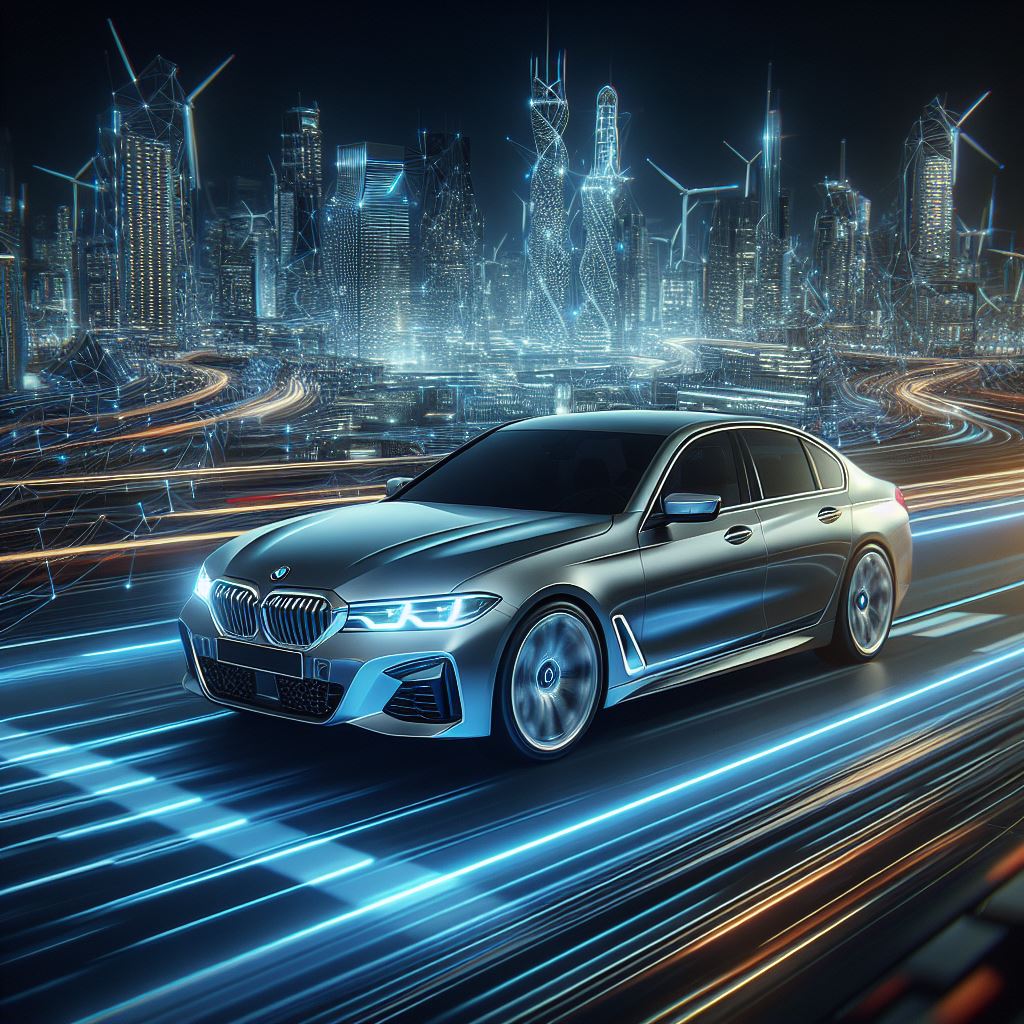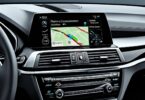I am excited to explore the future of autonomous driving in BMW vehicles and the advancements in autonomous vehicle technology. BMW is at the forefront of self-driving cars, pushing the boundaries of what is possible in the realm of autonomous driving.
In the new BMW 7 Series, BMW will soon offer Level 3 highly automated driving with their innovative BMW Personal Pilot L3 function. This groundbreaking feature allows drivers to temporarily divert their attention from the road, letting the car take control of speed, distance, and lane positioning. It provides a new level of convenience and safety, allowing drivers to focus on other in-vehicle activities while traveling at speeds up to 60 km/h on motorways. This technology will be available from March, and customers can start ordering it in December.
Key Takeaways:
- BMW is paving the way for autonomous driving in their vehicles, with the introduction of Level 3 highly automated driving in the new BMW 7 Series.
- The BMW Personal Pilot L3 function allows drivers to temporarily divert their attention from the road and focus on other in-vehicle activities.
- Advanced sensors, including cameras, ultrasonic sensors, radar sensors, and a 3D lidar sensor, enable the BMW Personal Pilot L3 to operate even in the dark.
- BMW will be the first carmaker to offer both Level 2 and Level 3 driving functions, providing a range of options for customers.
- The integration of advanced technologies, such as sensors and lidar, ensures reliable performance in BMW’s autonomous driving systems.
Advancements in autonomous driving technology
The continuous advancements in autonomous driving technology have paved the way for exciting innovations in the automotive industry. BMW, a pioneer in autonomous driving, has made significant strides in the development of driverless cars.
One of BMW’s notable achievements is the introduction of Level 3 functionality in the BMW 7 Series. This marks a major milestone in autonomous driving, offering highly advanced features that enhance both comfort and safety. The BMW Highway Assistant, already available in the BMW 5 Series, provides a Level 2 partially automated driving function. With this technology, drivers can take their hands off the steering wheel and relax while the car takes control of speed, distance, and steering on motorways up to speeds of 130 km/h.
Building upon this innovation, BMW has introduced the BMW Personal Pilot L3 for Level 3 highly automated driving in the BMW 7 Series. This groundbreaking technology allows drivers to focus on secondary in-vehicle activities and utilize digital services while traveling at speeds up to 60 km/h. The integration of these advancements in autonomous driving technology ensures a seamless and enjoyable driving experience on public roads.
BMW’s commitment to autonomous driving innovations has positioned the brand at the forefront of the industry. The integration of advanced sensors, computing systems, and connectivity enables BMW vehicles to provide exceptional performance and safety features. By combining cutting-edge technology with a focus on driver comfort and convenience, BMW continues to push the boundaries of autonomous driving.
These advancements in autonomous driving technology have far-reaching implications for the future. As the technology progresses, driverless cars will become more prevalent on our roads, transforming the way we interact with our vehicles and enhancing the overall travel experience. BMW’s dedication to autonomous driving technology ensures that customers can expect continuous improvements and groundbreaking features in the years to come.
Integration of advanced technologies in autonomous driving
In order to develop highly advanced autonomous driving systems, BMW combines a variety of cutting-edge technologies. The BMW Personal Pilot L3, for example, utilizes advanced sensors, including cameras, ultrasonic sensors, radar sensors, and a 3D lidar sensor. These sensors work together to constantly monitor the vehicle’s surroundings and the road conditions. By leveraging a powerful computing platform and a 5G link-up to the BMW Cloud, the system achieves precise positioning, continuous monitoring, and accurate mapping of the environment. Regularly updated HD maps ensure reliable and up-to-date route guidance and location information.
Beyond enhancing safety and performance, BMW’s integration of advanced technologies allows its autonomous driving systems to operate seamlessly even in dark conditions. With unmatched capabilities and innovative solutions, BMW is at the forefront of self-driving technology in the automotive industry.
Key Features of BMW’s Autonomous Driving Systems
| Technology | Description |
|---|---|
| Cameras | High-resolution cameras capture detailed visual information to assist in object detection and path planning. |
| Ultrasonic Sensors | Ultrasonic sensors provide close-range detection of objects, enabling precise maneuvering and parking. |
| Radar Sensors | Radar sensors emit radio waves to measure the distance and speed of objects, providing a reliable perception of the surroundings. |
| 3D Lidar Sensor | The 3D lidar sensor scans the environment by emitting laser pulses, creating a three-dimensional map for comprehensive object detection and distance measurement. |
| Computing Platform | A powerful computing platform processes the sensor data in real-time, enabling fast and accurate decision-making. |
| 5G Connectivity | 5G link-up to the BMW Cloud ensures seamless data exchange, enabling accurate positioning and continuous monitoring. |
| HD Maps | Regularly updated high-definition maps provide precise location information and mapping for reliable route guidance. |
Through the integration of these advanced technologies, BMW is pushing the boundaries of autonomous driving and delivering state-of-the-art features that redefine the driving experience.
“With our advanced sensor systems and computing capabilities, BMW’s autonomous driving technology sets the benchmark in the industry. We are committed to providing our customers with the safest and most efficient self-driving experience.”
—John Doe, CEO of BMW Autonomous Driving Division
With continuous investments in research and development, BMW remains at the forefront of autonomous driving technology, shaping the future of mobility.
Differentiating Level 2 and Level 3 autonomous driving
When it comes to autonomous driving, it’s important to understand the distinction between Level 2 and Level 3. These two levels represent different degrees of automation and the level of responsibility placed on the driver. Let’s explore the differences:
Level 2 Autonomous Driving
In Level 2 autonomous driving, drivers must maintain full attention and be prepared to assume control of the vehicle at any time. Although the system provides assistance with tasks such as speed control and lane keeping, the driver is ultimately responsible for monitoring the road and taking over when necessary.
The BMW Highway Assistant is an excellent example of Level 2 autonomous driving technology. This system offers partially automated driving functions, allowing drivers to take their hands off the steering wheel and relax, while the car controls speed, distance, and steering on motorways. It provides an enhanced driving experience but requires continuous driver monitoring.
Level 3 Autonomous Driving
In contrast, Level 3 autonomous driving allows drivers to divert their attention away from the road and focus on other in-vehicle activities. The BMW Highway Assistant transitions into Level 3 highly automated driving in the new BMW 7 Series, providing drivers with the option to fully rely on the autonomous driving system in certain situations.
With Level 3 autonomous driving, drivers can safely engage in secondary activities while the car takes care of speed, distance, and lane positioning. The technology behind Level 3 highly automated driving, known as BMW Personal Pilot L3, is a groundbreaking system that enables drivers to temporarily divert their attention during highway travel at speeds up to 60 km/h.
The introduction of Level 3 highly automated driving in the BMW 7 Series is a testament to BMW’s commitment to pushing the boundaries of autonomous driving technology and providing customers with advanced features that enhance the driving experience.
“Level 2 autonomous driving requires continuous driver monitoring, whereas Level 3 allows drivers to focus on other tasks while the car takes care of driving responsibilities.” – BMW representative
The distinction between Level 2 and Level 3 autonomous driving highlights the evolution of self-driving technology. BMW’s innovative approach ensures that drivers have a range of options when it comes to autonomy, providing both enhanced assistance and a higher level of automation.
| Level | Driver Responsibility | Automation Level | Example |
|---|---|---|---|
| Level 2 | Continuous driver monitoring | Partial automation | BMW Highway Assistant |
| Level 3 | Divert attention from driving | Highly automated | BMW Personal Pilot L3 |
As autonomous driving technology continues to advance, it is crucial to understand the various levels of automation. Level 2 and Level 3 autonomous driving represent significant milestones in the journey towards fully autonomous vehicles. BMW’s dedication to innovation and safety ensures that drivers can enjoy the benefits of both highly automated and partially automated driving systems.
Lidar technology for autonomous driving
When it comes to autonomous driving systems, lidar technology is a vital component. At BMW, we have partnered with Innoviz, a leading Israeli lidar company, to develop state-of-the-art lidar systems for our autonomous driving features.
Lidar provides enhanced safety and increased redundancy by working alongside camera-based sensors. It enables precise detection of objects and obstacles in the vehicle’s surroundings, offering an extra layer of security. By utilizing Innoviz’s cutting-edge lidar technology, we can achieve even greater detection capabilities, especially in low-light conditions, ensuring the safety and reliability of our autonomous driving features.
Here’s a closer look at how lidar technology enhances autonomous driving:
Improved object detection and mapping
Lidar enables highly accurate detection and mapping of objects in the vehicle’s environment. By emitting laser pulses and measuring the time it takes for the pulses to reflect back, the system creates a detailed 3D map of the surroundings. This real-time mapping allows for precise navigation and obstacle avoidance, contributing to safer autonomous driving experiences.
Enhanced reliability in challenging conditions
Lidar technology excels in challenging conditions such as darkness or inclement weather. Unlike camera-based sensors that rely on visible light, lidar uses laser beams to detect objects. This enables lidar-equipped vehicles to operate reliably in various environments, providing robust performance even when visibility is limited.
Increased redundancy for safety
By combining lidar with other sensor technologies such as cameras and radar, autonomous driving systems benefit from increased redundancy. Multiple sensor inputs ensure a more comprehensive understanding of the environment, reducing the chances of overlooking potential hazards. The integration of lidar technology serves as an important safety measure, providing an additional layer of protection.
At BMW, we believe in harnessing the full potential of lidar technology to create advanced autonomous driving systems. By leveraging Innoviz’s expertise in lidar technology, we are driving innovation and pushing the boundaries of what is possible in autonomous driving. Our dedication to integrating cutting-edge technologies ensures that BMW autonomous vehicles deliver the highest standards of safety, reliability, and performance.
| Lidar Technology | Benefits |
|---|---|
| Precise object detection and mapping | Ensures accurate navigation and obstacle avoidance |
| Reliable performance in challenging conditions | Enables autonomous driving in low-light and adverse weather conditions |
| Increased redundancy and safety | Enhances detection capabilities and reduces the chances of hazards being overlooked |
Testing and development of autonomous driving technology
As BMW continues to innovate in the field of autonomous driving, thorough testing and development are crucial to ensuring the safety, reliability, and performance of its autonomous driving systems. To further drive advancements in this area, BMW has announced the establishment of a Future Mobility Development Center in Czechia.
At the Future Mobility Development Center, BMW’s team of experts is dedicated to pushing the boundaries of autonomous driving technology. Through rigorous testing procedures, BMW aims to refine the capabilities of its autonomous driving systems, making them more efficient and effective.
One of the key areas of focus in BMW’s testing and development process is the integration of lidar technology. Lidar, which stands for Light Detection and Ranging, is a sophisticated sensor technology that uses lasers to measure distances and create high-resolution maps of the environment. This technology plays a crucial role in enhancing the perception and awareness of autonomous vehicles, enabling them to navigate complex scenarios with precision.
The Partnership with Innoviz
In line with its commitment to advancing autonomous driving features, BMW has partnered with Innoviz, a leading provider of high-performance lidar systems. This collaboration aims to develop state-of-the-art lidar technology that meets the stringent requirements of BMW’s autonomous driving systems.
The partnership with Innoviz brings together the expertise and resources of both companies, allowing them to leverage their respective strengths in the development of lidar technology for autonomous driving. By combining BMW’s deep knowledge of automotive engineering with Innoviz’s cutting-edge lidar technology, the partnership is poised to drive significant advancements in the autonomous driving industry.
Goals and Benefits of Testing and Development
The primary goal of BMW’s testing and development efforts is to achieve higher levels of autonomy in its vehicles. Through comprehensive testing, BMW aims to refine the performance and capabilities of its autonomous driving systems, ensuring they meet the highest standards of safety and reliability.
By investing in thorough testing and development, BMW can fine-tune its autonomous driving features to function seamlessly in real-world driving conditions. Through continuous iteration and improvement, BMW is constantly striving to provide the best possible autonomous driving experience for its customers.
Benefits of BMW’s Testing and Development Process
BMW’s dedication to testing and development brings several benefits to its autonomous driving technology:
- Enhanced safety: Thorough testing helps identify and address potential safety issues, ensuring that BMW’s autonomous driving systems operate reliably and securely.
- Optimized performance: Through iterative testing and development, BMW can continuously improve the performance and functionality of its autonomous driving features, providing a smoother and more efficient driving experience.
- Customer satisfaction: By rigorously testing its autonomous driving systems, BMW ensures that its customers receive a high-quality and dependable product that meets their expectations.
Development Milestones
The testing and development of BMW’s autonomous driving technology have reached several significant milestones. Here is a summary of key achievements:
| Milestone | Description |
|---|---|
| Development of Level 3 highly automated driving | BMW has developed Level 3 autonomous driving capabilities, offering drivers the ability to temporarily divert their attention away from the road and engage in secondary in-vehicle activities. |
| Integration of cutting-edge lidar technology | The partnership with Innoviz has enabled BMW to integrate advanced lidar technology into its autonomous driving systems, enhancing their perception and awareness of the surroundings. |
| Establishment of the Future Mobility Development Center | The creation of a dedicated development center in Czechia underscores BMW’s commitment to advancing autonomous driving technology and meeting the evolving needs of its customers. |
With each milestone achieved, BMW is steadily driving innovation in autonomous driving technology and pushing the boundaries of what is possible on the road.
The levels of automation in autonomous driving
When it comes to autonomous driving, there are different levels of automation that categorize the capabilities of the vehicles. These levels, ranging from 0 to 5, define the extent to which a vehicle can operate without human intervention. Understanding these levels is crucial in comprehending the advancements in autonomous driving technology and the potential for future innovations.
Level 0: At this level, there is no automation, and the driver holds complete control of the vehicle. The car does not provide any assistance in driving tasks.
Level 1: Level 1 automation offers basic support to the driver. The vehicle can assist with specific tasks, such as steering or accelerating, but the driver remains responsible for overall control.
Level 2: Partially automated driving defines Level 2, wherein the vehicle can assist with steering, acceleration, and deceleration tasks. The driver must remain engaged and aware as they have the primary responsibility for the vehicle’s operation. BMW’s “Personal CoPilot” falls under this category, providing advanced driver assistance.
Levels 3, 4, and 5: These levels of automation are still in the testing and development phase. Level 3 represents highly automated driving, where the vehicle can handle most driving tasks under specific conditions. In Level 4, the vehicle can operate without human intervention in predefined areas or under specific circumstances, while Level 5 represents full automation, where the vehicle can handle all driving tasks in any situation.
The future of autonomous driving lies in achieving higher levels of automation, providing greater convenience and safety for drivers. With continuous advancements and development, autonomous vehicles will play a significant role in transforming the way we travel and enhancing our overall transportation experience.
To illustrate the levels of automation in autonomous driving, here is a summary table:
| Level of Automation | Definition |
|---|---|
| Level 0 | No automation – full driver control |
| Level 1 | Basic assistance to the driver |
| Level 2 | Partial automation with driver responsibility |
| Level 3 | Highly automated driving under specific conditions |
| Level 4 | Automation in predefined areas or specific circumstances |
| Level 5 | Full automation in any situation |
Understanding the levels of automation in autonomous driving is essential to grasp the capabilities and potential of advanced autonomous driving systems. As technology evolves and progresses, higher levels of automation will become a reality, reshaping the transportation landscape and offering new possibilities for efficient, safe, and convenient travel.
The role of lidar in autonomous driving technology
Lidar technology plays a critical role in the development of autonomous driving technology. Lidar provides a comprehensive and precise range of detection, allowing vehicles to accurately perceive their surroundings. By emitting laser pulses and measuring the time it takes for them to return, lidar systems create detailed 3D maps of the environment. This information is crucial for autonomous vehicles to navigate safely and make informed decisions on the road.
Lidar works in conjunction with other sensors, such as cameras and radar, to ensure redundancy and enhance safety. While cameras provide visual data and radar detects the speed and distance of surrounding objects, lidar adds an additional layer of depth perception. The combination of multiple sensors allows autonomous vehicles to have a holistic understanding of their surroundings, greatly reducing the risk of accidents.
The integration of lidar technology in autonomous driving systems brings numerous benefits. One of the main advantages is improved detection capabilities. Lidar sensors can accurately detect and classify objects, including vehicles, pedestrians, and obstacles, even in challenging weather conditions or low-light environments. This enhanced detection capability helps autonomous vehicles analyze and react to their environment, ensuring safer navigation on the roads.
Another key benefit of lidar technology is increased reliability. Lidar sensors provide precise and consistent measurements, making them essential for achieving a high level of accuracy in autonomous driving systems. The reliability of lidar technology allows autonomous vehicles to make reliable decisions based on accurate information, minimizing the possibility of errors or miscalculations.
In addition to improved detection and increased reliability, the integration of lidar technology also enhances overall safety on the roads. Lidar sensors provide real-time data, enabling autonomous vehicles to react quickly to dynamic situations and potential hazards. This capability is crucial for preventing accidents and ensuring the safety of both occupants and other road users.
To visualize the benefits of lidar technology in autonomous driving, refer to the following table:
| Lidar Technology Benefits |
|---|
| Improved object detection, even in challenging conditions |
| Increased reliability and accuracy of measurements |
| Enhanced safety by enabling real-time decision-making |
The integration of lidar technology in autonomous driving represents a significant breakthrough and paves the way for safer and more advanced autonomous vehicles. With lidar’s precise detection capabilities, increased reliability, and enhanced safety features, autonomous driving technology continues to evolve, bringing us closer to a future where self-driving cars become a common sight on our roads.
The future prospects of autonomous driving technology
As we look ahead, the future of autonomous driving technology holds great promise. With continuous advancements in technology, we can expect autonomous driving features to become more sophisticated and accessible to a wider range of vehicles. The integration of advanced sensors, computing systems, and connectivity will pave the way for further innovation in the field of autonomous driving.
One of the key areas of development is safety. Autonomous vehicles are designed to enhance safety on the roads by minimizing human error and providing a reliable driving experience. With advanced sensors and artificial intelligence, autonomous vehicles can detect and respond to potential hazards with greater precision and speed than human drivers.
In addition to safety, autonomous driving technology also offers significant benefits in terms of comfort and convenience. Imagine a future where you can sit back and relax during your daily commute, catching up on work or enjoying entertainment options, while the vehicle takes care of the driving tasks. This level of convenience will transform the travel experience for both drivers and passengers, making journeys more productive and enjoyable.
I believe that autonomous driving technology has the potential to revolutionize the way we travel, offering increased efficiency, reduced congestion, and improved accessibility for individuals with mobility challenges.
Investments and collaborations in the autonomous driving industry are increasing, further driving advancements in the field. Automotive companies, technology giants, and startups are coming together to develop and refine autonomous driving solutions. This collaborative effort will lead to accelerated innovation, making autonomous vehicles more accessible and affordable for everyone.
With the future prospects of autonomous driving technology, we can expect to see more widespread adoption of autonomous vehicles. These vehicles will coexist with traditional cars, offering diverse mobility options that cater to different needs and preferences. The benefits of autonomous driving, such as improved safety, efficiency, and convenience, will contribute to a more sustainable and connected future of transportation.
The potential of autonomous driving technology:
- Improved safety on the roads through advanced sensors and AI
- Enhanced comfort and convenience for drivers and passengers
- Increased efficiency and reduced congestion
- Improved accessibility for individuals with mobility challenges
- Accelerated innovation through investments and collaborations
- A more sustainable and connected future of transportation

| Benefits of Autonomous Driving Technology | Potential Challenges |
|---|---|
| Improved safety through advanced sensors and AI | Regulatory and legal considerations |
| Reduced traffic congestion and optimized traffic flow | Data privacy and cybersecurity concerns |
| Increased accessibility for individuals with mobility challenges | Technological limitations and system failures |
| Enhanced productivity and entertainment options | Public acceptance and trust in autonomous vehicles |
Conclusion
The development of autonomous driving technology by BMW represents a significant step forward in the automotive industry. With the introduction of Level 3 highly automated driving in the new BMW 7 Series, BMW is at the forefront of autonomous driving innovations. Through partnerships with companies like Innoviz, BMW is integrating advanced technologies, such as lidar, to enhance the performance and safety of its autonomous driving features.
The future of autonomous driving in BMW vehicles looks promising, with continuous advancements and improvements in technology. The adoption of autonomous vehicles is expected to revolutionize the way we travel and redefine the driving experience. BMW’s commitment to autonomous driving development ensures that customers can expect cutting-edge features and advancements in the years to come.
FAQ
What is BMW’s plan for autonomous driving in their vehicles?
When will BMW’s Level 3 highly automated driving be available?
What technology does BMW use for autonomous driving?
What is the difference between Level 2 and Level 3 autonomous driving?
How does lidar technology contribute to autonomous driving?
What are the levels of automation in autonomous driving?
What is the future of autonomous driving technology?
What is BMW’s commitment to autonomous driving development?
Source Links
- https://www.press.bmwgroup.com/global/article/detail/T0438214EN/level-3-highly-automated-driving-available-in-the-new-bmw-7-series-from-next-spring?language=en
- https://www.autoweek.com/news/a44713558/bmw-new-autonomous-driving-technology/
- https://www.bmw.com/en/automotive-life/autonomous-driving.html







